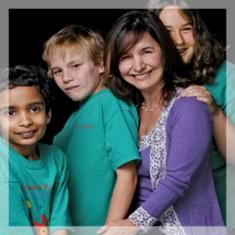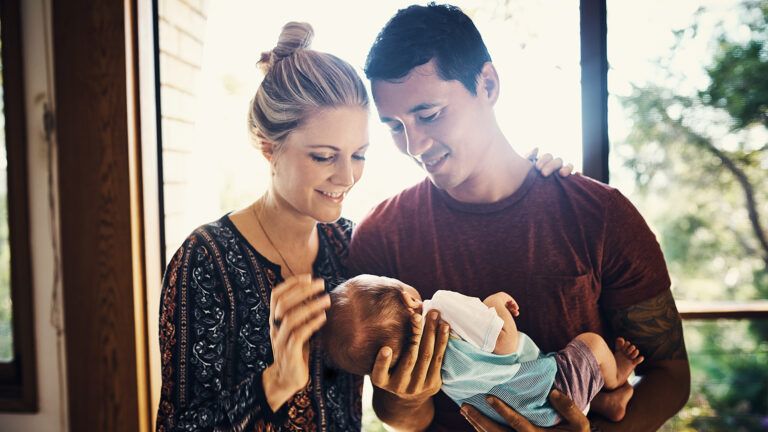“Neal, please!” I begged, bleary-eyed, tucking my seven-year-old son into bed for the third time that night. “We’ve got to get some sleep.” Neal just shook his head. It had been a difficult evening. First, at the dinner table, Neal threw his silverware. Later, he ran from his bath into his room.
It took me an hour to coax him back into the tub, and even then he thrashed so much I feared he’d hurt himself. Now I kissed him goodnight on the forehead for the third time and turned toward the door. Please, God…. But Neal threw off the covers again and screamed.
I burst into tears. I was ready to scream myself. God, help me find an answer for Neal.
My then-husband and I adopted Neal from Russia when he was just a toddler. I fell in love instantly. Love made me miss the signs. Sometimes Neal was like a whirling dervish, opening and slamming doors, spinning around in circles. Other times he just sat quietly and stared at his hands.
“You know, Neal never responds to his name,” my mother-in-law observed. He was in an orphanage, I reasoned. He just hasn’t adjusted yet. When Neal acted strange—running around, spinning—I spun with him. Neil giggled with me.
He was sensitive to loud noises, bright lights, tight clothes, small spaces. He didn’t interact with other children on play dates, sitting by himself, playing with his Matchbox cars, which he allowed no one to touch. And he never spoke.
We brought him to the pediatrician. “Your son has autism,” the doctor told us.
We would deal with it, I vowed. But the strain was too much for our marriage, as it is for so many couples who raise children with disabilities. And no therapy or special school seemed to work for my son.
The only thing that seemed to help was joining Neal in his world, mirroring his actions and playing his games. I needed to spend more time with him, so I quit my job as a professional acting coach and took a part-time job as a consultant for a children’s theater group.
I learned how to calmly be with Neal through his tantrums, his seemingly odd behavior, those heartbreaking moments when he seemed so isolated in his own world, a world it seemed I could never reach.
But now I was divorced and had to care for Neal. How could I do it? I couldn’t even get him to go to bed.
I remembered a prayer the Rabbi at our temple taught me, the bedtime blessing that asks the angels to protect us while God watches over. That’s what we need right now, I thought.
I stroked Neal’s short blond hair and covered him gently with the blanket again. Then I sang the prayer, softly: “May the angel Michael be at your right, and the angel Gabriel at your left. And in front of you the angel Uriel, and behind you the angel Raphael, and above you the divine presence of God.”
I visualized the angels surrounding him, God watching over the two of us. Neal’s eyes closed, his breathing slowed. The singing seemed to calm him. Before long, he was fast asleep. I, on the other hand, tossed and turned, worried. I needed to find someone who could help me with Neal.
The next day I had to go help out the theater group. I tried to put Neal out of my mind, knowing I needed to concentrate on the young actors. They began with some vocal warm-ups, making strange sounds to help loosen their tongues and enunciate clearly.
“Bah, bah!” Just like the noises Neal sometimes made….
Next, the actors pretended they were animals. Some crawled around, others climbed all over the seats. One even jumped around in a circle. I could just picture Neal, running and rolling around, doing silly things.
Then it hit me. Actors were used to being playful, expressing themselves in unconventional ways. If anyone could understand Neal, they could. Maybe some of the acting coaches could work with Neal at home, doing some of the same things we did in class.
“Would anyone be willing to work with my son who has autism?” A bunch volunteered. Even the lighting director, Tom. “I’d love to help out,” he said.
Neal struggled as I got him dressed and ready for his first visit from Tom. He probably thinks we’re heading to another therapy session, I thought. Tom arrived and I led him to Neal. I took a deep breath, praying this would work out.
Neal was busy stacking his Matchbox cars in a pile. He pulled back when Tom approached. But Tom knelt down beside him. “You ready to have some fun?” he asked. Neal just clutched a car to his chest.
Tom picked up one of Neal’s cars. “Vroom,” Tom said, making engine sounds, as he made a stack next to Neal’s. I looked over at Neal. How long would it be before he acted out?
What I saw stunned me…Neal, sitting quietly, his face a mask of amazement. They stacked cars side by side for a while. Then, suddenly, Neal shot Tom a smile. “Vrrr!” he shouted.
The actors and other theater volunteers loved working with Neal. At first they followed his lead, but slowly, Neal began to follow theirs. They danced to music, and he danced too, waving his arms in the air, grinning from ear to ear.
Getting Neal to stop throwing things was a challenge. So I bought him a plush ball to throw around, and the actors and I played a game of volleyball with him. Soon, he stopped throwing silverware.
Then he started trying to hang things, like chairs on a coat rack, so I bought hangers, glue and construction paper, and a few of the actors and I helped Neal make mobiles instead. They sang songs with Neal, played the guitar. Neal loved it.
Eventually, 10 hours a day, I or one of the actors played with Neal. One morning Neal had a breakthrough. He ran up to Tom and handed him his favorite Matchbox car. Neal was coming out of his shell.
“I wish you would start a program like that for other kids with special needs,” said a friend who had a son with cerebral palsy. “I know many parents would love it. You could probably get a grant too.”
It hit me like a bolt. As if God were saying, I helped show you how to take care of Neal. Now you can show others.I had never written a grant proposal before—but I’d never done a lot of things before until now: raise a child with autism, survive a divorce, learn to be a single mom.
So I sat down at my computer one day and the plan just flowed out of me. Teach children with special needs to perform a musical. Autism is a disorder of isolation. Through singing, dancing and acting, these kids could learn to interact with the world. I called it The Miracle Project.
In July 2004 I got the grant. I ran an ad online, looking for volunteers to help with the acting, singing and choreography. “I’ve never worked with special-needs kids,” most of them said. I had to admit that the only one I’d worked with was Neal.
That first day, the room was sheer chaos. Sixteen kids, all doing their own thing, oblivious to my attempts to get started. “Let’s sit down in a circle and introduce ourselves,” I called.
One kid, Stephen, stood in the doorway, afraid to come in, hugging his mother tight. Another sat in a corner, scribbling energetically on a piece of paper. Others ran in circles, stared into space or just wandered off. Even Neal seemed skeptical.
I hummed to myself the little angel prayer: May the angel Michael be at my right, Gabriel at my left…
I needed to learn what these kids liked to do and make those activities part of the musical. Just like with Neal. I played some music and one of the girls sang along. “Our soloist!” I declared. And that was the start.
The lyricist and pianist taught her a song to sing onstage. One boy complained he was picked on by bullies. “How’d you like to play a bully onstage?” I asked.
“Knock, knock,” another boy, Izzy said to me one day.
“Who’s there?” I asked.
“Me!” he said, laughing hysterically.
“I think we found our comic relief,” I said.
Now came the hard part. Figuring out how to deal with an audience. A live performance could be too scary for the most challenged kids. For them, I decided we would make a film to show in between scenes in the play.
We had a very small space and an even smaller crew. All I wanted was a couple of scenes from the Bible. David versus Goliath, the parting of the Red Sea. We chose Stephen to be David.
Stephen’s mom was worried. “He’s scared of being photographed,” she said. “It’ll be too uncomfortable for him. He’ll get upset.”
Then Stephen interrupted. “I want to do it!” The day of the filming, Stephen bravely slew Goliath.
I had no idea how Neal would react in that small room with the camera in his face and other kids running around. His role was Nachshon, the first of the slaves who crossed the Red Sea when Moses put down his staff.
Neal waited patiently for his cue. “Action,” I said. Neal stepped forward. He hit all his marks, walking in a straight line while some of the other kids pretended to be the parting waves. I felt so proud, like any other parent seeing her kid in a play.
We put on a performance at the Odyssey Theatre, one of the nicest in Los Angeles. The musical was a success. “I’m a miracle,” our “bully” said, striding confidently across the stage like a seasoned stage veteran. Izzy told his jokes to gales of laughter. I hugged Neal tight while the audience watched his scene in the film, applauding. I stole a glance at his astonished expression at seeing himself on the big screen.
I couldn’t help but think of the incredible journey his life had been—from an orphanage in Russia to a spotlighted stage in America. Indeed, his path had not been like most others and so often he had traveled in the isolation of autism.
Yet I had found a way for his world—and those of the other kids in the show—to connect with ours. And at that juncture, that portal, was the grace of God.
Download your FREE ebook, Rediscover the Power of Positive Thinking, with Norman Vincent Peale





